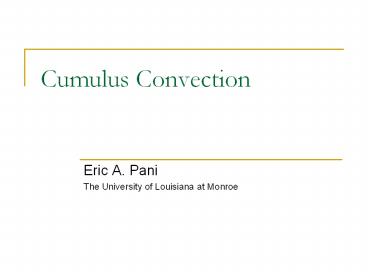Cumulus Convection - PowerPoint PPT Presentation
1 / 10
Title:
Cumulus Convection
Description:
Cumulus Convection. Eric A. Pani. The University of Louisiana at Monroe. Overview ... As the sample rises, it entrains a mass dm of unsaturated environmental air. ... – PowerPoint PPT presentation
Number of Views:24
Avg rating:3.0/5.0
Title: Cumulus Convection
1
Cumulus Convection
- Eric A. Pani
- The University of Louisiana at Monroe
2
Overview
- Have taken simplified view of convection so far
- Only force considered has been buoyancy
- Are there other forces involved? If so, what are
they?
3
Entrainment
4
Mathematical Development
Consider a sample of saturated cloud mass, m,
ascending through a distance dz and experiencing
a pressure change dp. As the sample rises, it
entrains a mass dm of unsaturated environmental
air. Model the rising as a saturated adiabatic
cooling of m, an isobaric cooling of m and
warming of dm during mixing, and the evaporation
of part of the liquid water content of m into dm
to produce a final mixture which is saturated.
We will assume that the cloud is horizontally
uniform in temperature, water vapor, and liquid
water and that there are no sources or sinks of
heat.
5
(No Transcript)
6
(No Transcript)
7
(No Transcript)
8
(No Transcript)
9
Results from
- If entrainment rate ( ) gt 0 and cloud is
buoyant, then cloud cools faster than moist
adiabatic - Example at 700 mb, -1C, and 67 environmental
RH, if cloud is at 0C, then moist adiabatic
lapse rate is 5.8C/km compared to cloud lapse
rate of 6.6C/km if entrainment rate is 0.25/km - Typical entrainment rates are 1-2/km (i.e., cloud
doubles or triples its mass with each km of
ascent)
10
Where does entrained air go?
- Large entrainment rates indicate cloud mass is
increasing quickly - Would expect width of cloud to increase with
height, but observations do not support this - Some air must move downward in downdrafts not
modeled by theory































